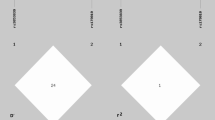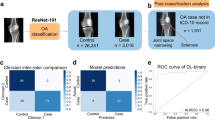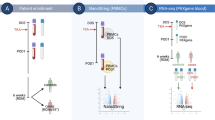Abstract
A genetic association of osteoarthritis (OA) and functional polymorphisms in the aspartic acid (D) repeat of the asporin gene was reported in Japanese and European Caucasians; however, the results were controversial. Our objective was to evaluate whether the D repeat polymorphism was associated with knee OA in Han Chinese. The D repeat polymorphism was genotyped in 218 patients who suffered from primary symptomatic knee OA with radiographic confirmation and in 454 age-matched controls, and the allelic association of the repeat was examined. Frequencies of the D13 and D14 alleles were similar to those of Japanese, but different from those of European Caucasians. The D14 allele was significantly over-represented in knee OA patients (P=0.0013; odds ratio 2.04; 95% confidence interval 1.32–3.15). D14 was more frequent in early-onset patients than in late-onset patients (P=0.043) and the age at onset in patients with D14 was earlier (P=0.028; log-rank test). Thus, the association of the D14 allele with knee OA susceptibility was replicated in Han Chinese. This was the first instance that association of the OA susceptibility gene was definitely replicated between different ethnic groups.
Similar content being viewed by others
Log in or create a free account to read this content
Gain free access to this article, as well as selected content from this journal and more on nature.com
or
References
Bamshad M, Wooding S, Salisbury BA, Stephens JC (2004) Deconstructing the relationship between genetics and race. Nat Rev Genet 5:598–609
Henry SP, Takanosu M, Boyd TC, Mayne PM, Eberspaecher H, Zhou W, de Crombrugghe B, Hook M, Mayne R (2001) Expression pattern and gene characterization of asporin. A newly discovered member of the leucine-rich repeat protein family. J Biol Chem 276:12212–12221
Ikegawa S, Kawamura S, Takahashi A, Nakamura T, Kamatani N (2006) Replication of association of the D-repeat polymorphism in asporin with osteoarthristis. Arthritis Res Ther 8:403 (Epub ahead of print)
International HapMap Consortium (2005) A haplotype map of the human genome. Nature 437:1299–1320
Kaliakatsos M, Tzetis M, Kanavakis E, Fytili P, Chouliaras G, Karachalios T, Malizos K, Tsezou A (2006) Asporin and knee osteoarthritis in patients of Greek origin. Osteoarthritis Cartilage 14:609–611
Kellgren JH, Lawrence JS (1963) Radiological assessment of osteoarthrosis. Ann Rheum Dis 22:237–255
Kizawa H, Kou I, Iida A, Sudo A, Miyamoto Y, Fukuda A, Mabuchi A, Kotani A, Kawakami A, Yamamoto S, Uchida A, Nakamura K, Notoya K, Nakamura Y, Ikegawa S (2005) An aspartic acid repeat polymorphism in asporin inhibits chondrogenesis and increases susceptibility to osteoarthritis. Nat Genet 37:138–144
Lorenzo P, Aspberg A, Onnerfjord P, Bayliss MT, Neame PJ, Heinegard D (2001) Identification and characterization of asporin. A novel member of the leucine-rich repeat protein family closely related to decorin and biglycan. J Biol Chem 276:12201–12211
Loughlin J (2005) The genetic epidemiology of human primary osteoarthritis: current status. Expert Rev Mol Med 7:1–12
Mustafa Z, Dowling B, Chapman K, Sinsheimer JS, Carr A, Loughlin J (2005) Investigating the aspartic acid (D) repeat of asporin as a risk factor for osteoarthritis in a UK Caucasian population. Arthritis Rheum 52:3502–3506
Rodriguez-Lopez J, Pombo-Suarez M, Liz M, Gomez-Reino JJ, Gonzalez A (2006) Lack of association of a variable number of aspartic acid residues in the asporin gene with osteoarthritis susceptibility: case-control studies in Spanish Caucasians. Arthritis Res Ther 8:R55
Walsh PS, Metzger DA, Higuchi R (1991) Chelex 100 as a medium for simple extraction of DNA for PCR-based typing from forensic material. Biotechniques 10:506–513
Zhang Y, Hunter DJ, Nevitt MC, Xu L, Niu J, Lui LY, Yu W, Aliabadi P, Felson DT (2004) Association of squatting with increased prevalence of radiographic tibiofemoral knee osteoarthritis. Arthritis Rheum 50:1187–1192
Acknowledgment
This work is supported by the National Nature Science Foundation of China (30571874).
Author information
Authors and Affiliations
Corresponding author
Electronic supplementary material
Rights and permissions
About this article
Cite this article
Jiang, Q., Shi, D., Yi, L. et al. Replication of the association of the aspartic acid repeat polymorphism in the asporin gene with knee-osteoarthritis susceptibility in Han Chinese. J Hum Genet 51, 1068–1072 (2006). https://doi.org/10.1007/s10038-006-0065-6
Received:
Accepted:
Published:
Issue date:
DOI: https://doi.org/10.1007/s10038-006-0065-6
Keywords
This article is cited by
-
FTO variant is not associated with osteoarthritis in the Chinese Han population: replication study for a genome-wide association study identified risk loci
Journal of Orthopaedic Surgery and Research (2018)
-
Functional polymorphisms in asporin and CILP together with joint loading predispose to hand osteoarthritis
BMC Genetics (2017)
-
An updated meta-analysis of the asporin gene D-repeat in knee osteoarthritis: effects of gender and ethnicity
Journal of Orthopaedic Surgery and Research (2017)
-
Overexpression of MMP13 in human osteoarthritic cartilage is associated with the SMAD-independent TGF-β signalling pathway
Arthritis Research & Therapy (2015)
-
TGF-β signal transduction pathways and osteoarthritis
Rheumatology International (2015)



